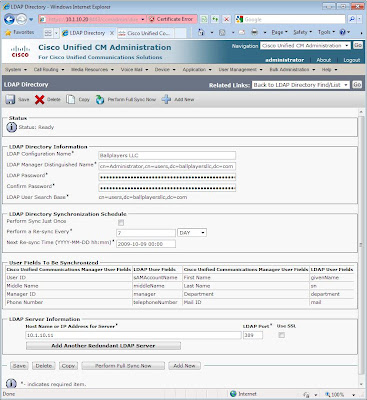CCIE Voice Lab 1.3 Tasks
1. Integrate UCM with LDAP / Active Director for user information. (Note, if you do not have AD in your lab, add the users manually.)
2. Assign the proper extension to each phone in New York and Los Angeles based on the information provided in CCIE Voice Lab 1 Scenario Background.
3. New York IP Phones should be SCCP; Los Angeles IP Phones should be SIP.
4. All phones should prefer UCMSUB01 as its preferred CUCM.
5. New York and Los Angeles IP Phones should reflect their appropriate timezones.
6. IP Phones at each location should use the G.722 codec. Calls between locations should use a low bandwidth, high-quality codec.
7. Both Ari and Arliss should be assigned a 7962 IP Phone.
8. Each users’ first name, last name, and four digit extension should be displayed on the line appearance of each phone.
CCIE Voice Lab 1.3 Solutions
1. Active Directory / LDAP integration involves three steps. First, begin with the basic LDAP System Configuration under System > LDAP > LDAP System and select Microsoft Active Directory under the LDAP Server Type and sAMAccountName under LDAP Attribute for User ID.
Next, configure LDAP Directory information under System > LDAP > LDAP Directory. Below is a screen shot.

Finally, provide the necessary credentials for LDAP Authentication under System > LDAP > LDAP Authentication. You can verify that your UCM is synchronizing with Active Directory by going to User Management > End User to verify that the system has been populated with the users.
2. Word of caution on the next steps…. While this is how I configured my phones, this process may not be the most expedient during the actual CCIE Voice Lab. Remember, time management is key. However, for learning purposes, here are the steps I followed for setting up the phones for New York and Los Angeles…
First, I begin be creating a CUCM group, “Ballplayers_Sub_Pub”, with the subscriber server first in priority.
Next, I created two Date/Time Groups, one for New York, and another for Los Angeles, with the appropriate timezone and NTP information.
Two Regions are then created, one for New York and one for Los Angeles, with the appropriate codecs assigned accordingly.
First, I begin be creating a CUCM group, “Ballplayers_Sub_Pub”, with the subscriber server first in priority.
Next, I created two Date/Time Groups, one for New York, and another for Los Angeles, with the appropriate timezone and NTP information.
Two Regions are then created, one for New York and one for Los Angeles, with the appropriate codecs assigned accordingly.
A Device Pool for both New York and Los Angeles is created. For each Device Pool, modify Cisco Unified Communications Manager Group, Date/Time Group, and Region. Below is the NewYorkDevicePool.
Lastly, I go to System > Cisco Unified CM and disable the Auto Registration previously configured in lab 1.2. This will come into play when we modify the Los Angeles phones for SIP.
3. At the conclusion of lab 1.2, the phones for New York and Los Angeles had registered with the Publisher (UCMPUB01) via auto configuration. By going to Device > Phone, the appropriate parameters for each phone can be modified. For New York SCCP phones, the following parameters are changed and/or configured:
Description > a helpful description for reference
Device Pool > select the device poolOwner User ID > select the end user
3. At the conclusion of lab 1.2, the phones for New York and Los Angeles had registered with the Publisher (UCMPUB01) via auto configuration. By going to Device > Phone, the appropriate parameters for each phone can be modified. For New York SCCP phones, the following parameters are changed and/or configured:
Description > a helpful description for reference
Device Pool > select the device poolOwner User ID > select the end user
Then, proceed to configure the line settings:
Configure the Los Angeles SIP phones requires a few extra steps. First, since the phones for Arliss Michaels and Kobe Bryant auto-registered as SCCP, they first must be deleted.. This was why auto-registration was disabled. If the phone were removed while auto-registration still enabled, the phones would simply re-register. Hint, note the MAC address of each phone prior to deletion. Then, manually add each device as a SIP phone. The process is very similar to adding a SCCP phone, except you need to modify some of the Protocol Specific Information, notably the Device Security Profile and SIP Profile. For now, select the defaults available in CUCM.









No comments:
Post a Comment